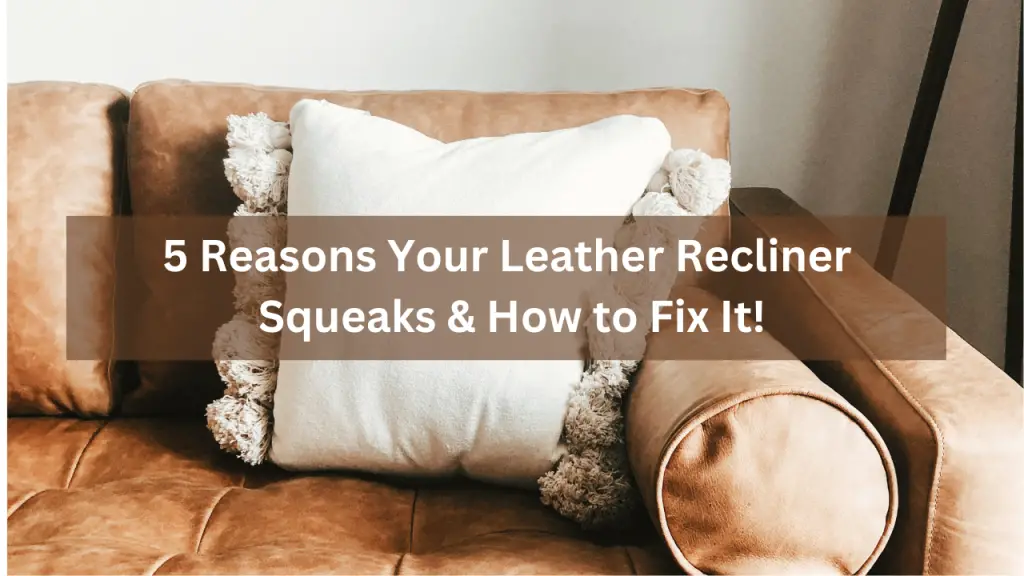
Few experiences can match the luxurious feel of sinking into a leather recliner at the end of a tiring day. But if that sumptuous retreat is compromised by annoying squeaks, it’s time to troubleshoot. From identifying common culprits to providing actionable solutions, this guide will help you restore the serenity of your leather recliner.
Why Your Leather Recliner Is More of a Noise Machine Than a Relaxation Haven
A leather recliner can start producing unsettling noises for various reasons—whether it’s brand new or has seen years of use. These are the primary factors:
New Leather Recliners: A Break-In Period Required
Fresh off the assembly line, new leather recliners might initially be a source of noise. The leather is stiff, and the mechanisms are unused. Over time, with regular usage, the leather becomes more pliable, and the sounds usually subside.
Tips for Quieting a New Recliner
- Invest in a high-quality leather conditioner to soften the leather. The more you sit, the more the leather will adapt to your shape, reducing the squeaks over time.
Dry Leather: The Crackling Culprit
If your leather recliner’s surface has lost its sheen and feels rough to the touch, it’s likely dry. When leather lacks moisture, it tends to make cringe-worthy sounds. The leather may even crack, causing irreversible damage.
How to Moisturize Dry Leather
- Consistent conditioning helps keep your leather soft and less prone to squeaking. You can either purchase a commercial leather conditioner or create your own blend using olive oil and vinegar.
Spring Deterioration: The Bouncy Problem
A worn-down spring can also be a source of incessant noise. The springs lose their tension over time and may need replacement to restore your chair to its former, quiet glory.
The Fix for Worn Springs
- Examine your chair for any signs of spring deterioration. If you find any, consider replacing the springs. Online tutorials can guide you through the process if you’re a DIY enthusiast.
Mechanical Friction: When Parts Don’t Glide
Rust and wear can cause your recliner’s mechanical components to grind against each other, resulting in squeaking noises. Dry bolts and joints particularly need your attention here.
Solution for Mechanical Issues
- Apply a silicone-based lubricant or vegetable oil to all metal parts, especially focusing on the joints. This simple act can do wonders in reducing noise.
Structural Flaws: When the Frame Fails You
Sometimes, the skeleton of your recliner may be the root cause of your problems. A loose or broken frame will not only creak but may also compromise your safety.
Repairing the Frame
- Inspect your recliner to see if any joints have loosened over time or if any parts are visibly damaged. Tightening or replacing the defective components often resolves the issue.
Maintenance: Ensuring Silence Reigns
Leather Conditioning: A Regular Routine
Frequent conditioning not only maintains the leather’s quality but also reduces squeaking. For an alternative approach, a thin layer of petroleum jelly can also do the trick, minimizing the friction between leather parts.
Greasing the Mechanical Parts
While silicone-based lubricants work wonders, WD-40 is an excellent option for ensuring the metal parts are both lubricated and protected from rust.
Regular Inspections: Nip it in the Bud
Regularly inspect your recliner for any loose screws or early signs of wear and tear. This proactive approach can prevent minor issues from escalating into more significant, noisier problems.
Concluding Thoughts
The tranquility of a squeak-free leather recliner is within reach. By identifying the underlying issue and taking appropriate measures, you can eliminate those pesky noises and go back to enjoying your relaxation time in peace.









